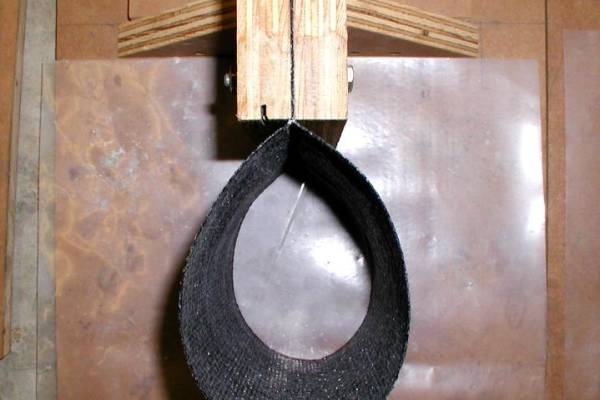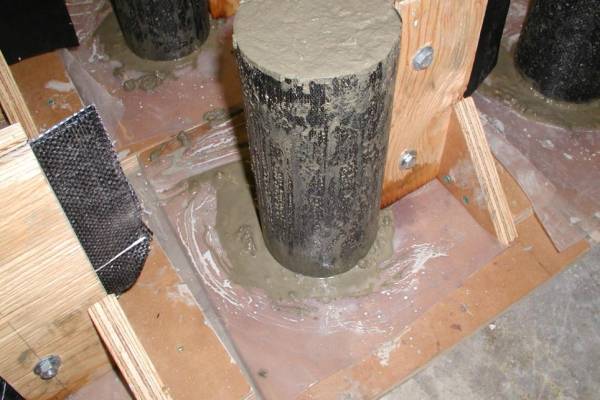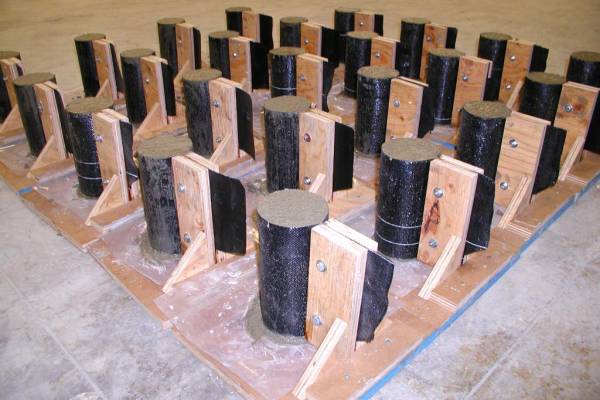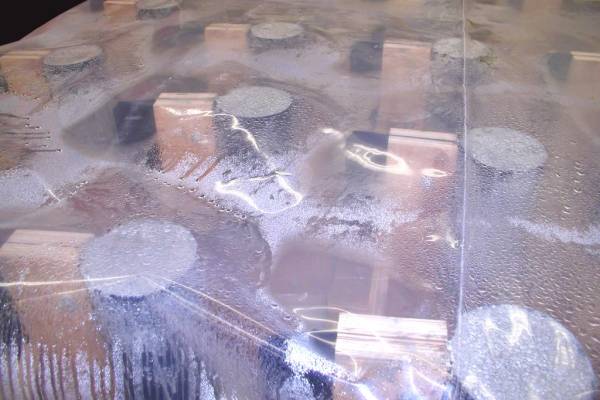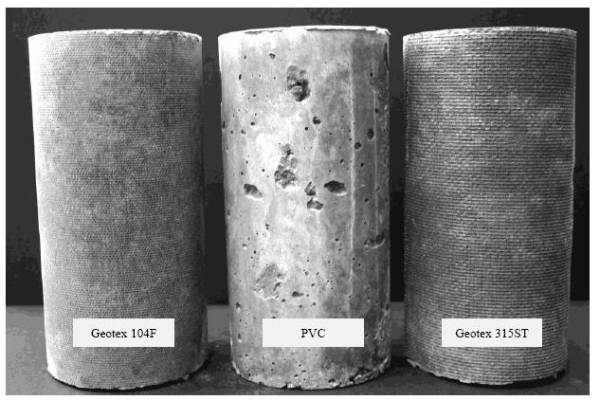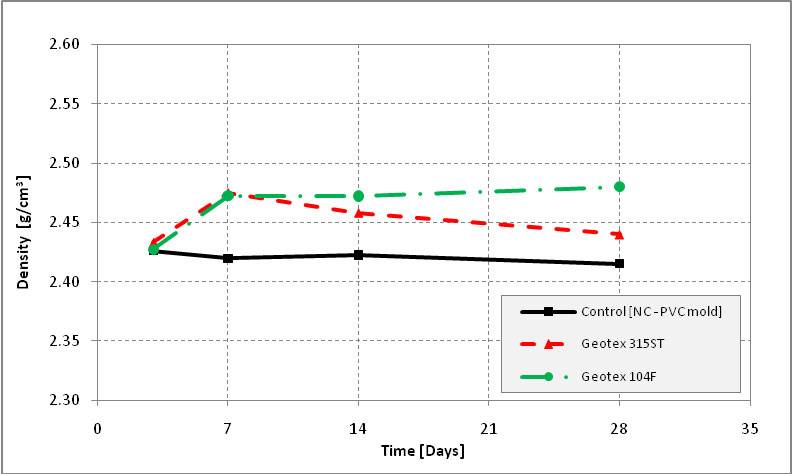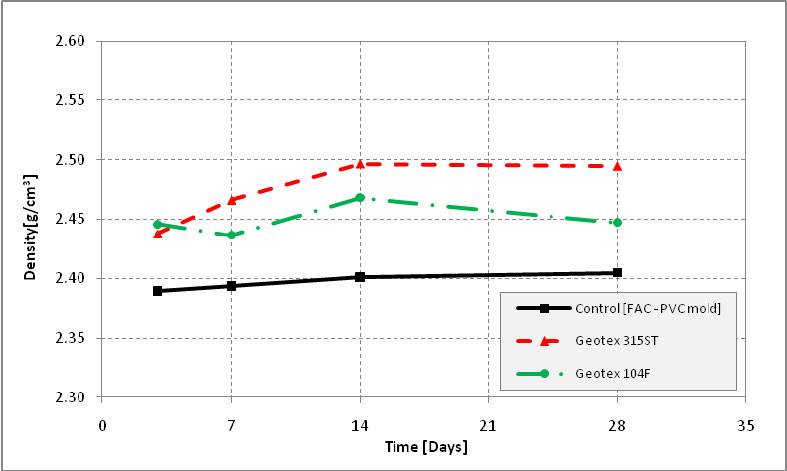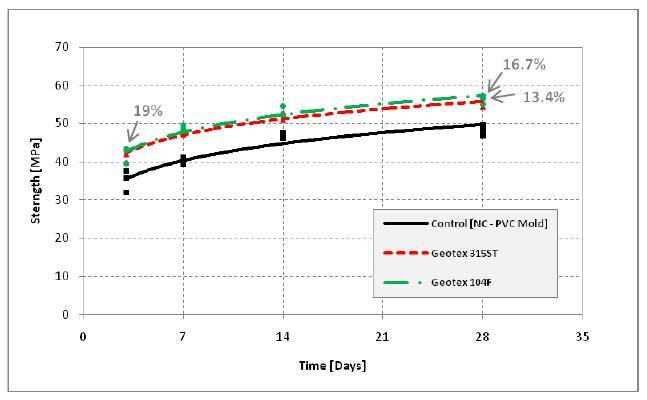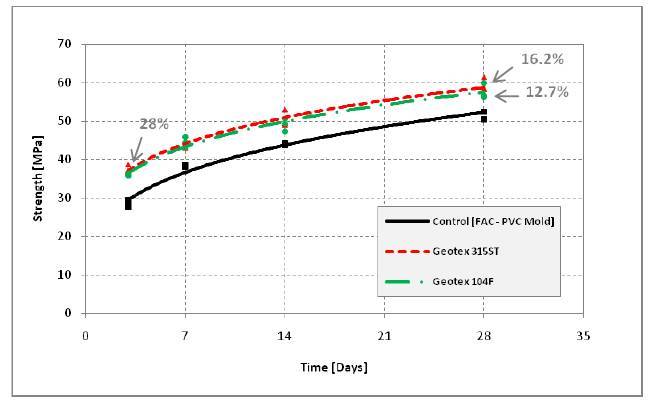Table of Contents
Strength Tests
Concrete cylinders were cast in the two fabric types and in watertight PVC molds, and tested for compression strength at the ages of 3, 7, 14 and 28 days. The difference in overall strength between fabric-formed cylinders and PVC cast cylinders was then used to gauge the effects of formwork on the strength of concrete.
Since no relationship between diameter of the specimen and the bleeding depth could be determined in the tests reported in Chapter 3, 101 by 203 mm (4 by 8 in.) cylinders were chosen for further tests. This allowed for fresh concrete to be produced in a single batch in the laboratory, more precise control over the mix design and the accuracy of the aggregate weight percentages. Large aggregates were separately and thoroughly washed in order to reduce the amount of dust and dirt and create a homogenous concrete. In this experiment, a total of 36 cylinders were cast using normal concrete: 12 cylinders by Geotex 315ST, 12 by Geotex 104F and, 12 by PVC control molds. The same number of flyash concrete cylinders was made for a total of 72 specimen cylinders. All cylinders were cured in a humidity/temperature controlled curing room before testing for compressive strength.
Casting and Testing Concrete Cylinders with Fabric Formwork
Both fabric-formed and PVC formed control cylinders were cast in a vertical position (Figure 33) and compacted using the standard placement and vibration procedures [1]. The bottom of each fabric formed cylinder was protected by a plastic sheet in order to prevent water absorption from the wood base, simulating the same condition as in the PVC molds (Figure 34). All PVC and fabric-formed specimens were cast using the same batch of fresh concrete made on premises. The same mix designs were adopted as in earlier tests [Table 2 and Table 3], (Chapter 2, Table 1 and Table 4). Aggregates were washed thoroughly and precise scaling was employed when weighing the aggregates. A 100 litre pan concrete mixer was used to mix the fresh concrete.
When the concrete was ready it was brought to the molds by wheel barrow for casting. Cylinders right after casting are shown in Figure 35. When casting the normal concrete, ambient temperature of the laboratory was recorded as 22 degree Celsius and the slump of the fresh concrete measured as 90 mm. For the flyash concrete, the temperature was recorded as 24 degree Celsius and the slump value was measured as 85 mm.
Two hours after casting, all specimens were covered with plastic sheets (Figure 36) and left in place for 24 hours. Sandwich boards, bolts and fabric forms were carefully taken off the fabric formed specimens after the first day. PVC cast hardened concrete cylinders were removed from the PVC molds after one day using air pressure. All specimens were then transferred to a curing room in order to maintain uniform curing conditions before testing. The temperature of the curing room was recorded as 20 degree Celsius and relative humidity as 100 percent.
When visually inspected, the surface of the specimens formed with fabric had a finely textured surface imprint. Unlike PVC formed samples, no large aggregate or bug holes were visible on the concrete surface. Figure 37 shows three cylinders cast from left to right, Geotex 104F, PVC and Geotex 315ST.
Due to flexibility of the fabric forms, final hardened cylinders had minimal variation in diameter (1 to 4 mm). In order to consider the difference between the diameters of the fabric formed specimens and companion control samples, the diameter of each fabric formed cylinder was measured at three points and then the average diameter value was used to find the actual area of each cylinder. The average variation in diameter between fabric formed cylinders and PVC formed cylinders was less than one percent. Cylinders were tested for compressive strength at the ages of 3, 7, 14 and 28 days.
Density
Samples were tested at 3, 7, 14 and 28 days using a compression testing machine at the University of Manitoba structures laboratory. Strength gains of fabric formed cylinders were compared to PVC formed cylinders. The densities of all cylinders were determined before testing in order to study the relationship between type of mold and the effect on density and strength of the hardened concrete. As seen in Figure 38 and Figure 39, regardless of type of concrete, fabric formed cylinders gained higher densities. When normal concrete was used, Geotex 104F gained higher density while Geotex 315ST shows higher density when flyash concrete is used. Compared to PVC-formed companion control samples, fabric-formed concrete cylinders showed an average of 2 percent higher overall density when normal concrete was used and 3.3 percent higher density when flyash concrete was used. This might be due to air and water loss through the porous mold wall. Studies suggest that increase in density of concrete can result in increase in compressive strength of concrete [2].
Strength Test Results
Figures 40 and 41 show strength for normal and flyash concrete respectively. The fabric formed normal concrete had about 19% higher strength at three days for both fabrics compared to PVC mold. After 28 days, Geotex 315ST cast normal concrete gained 13.4% of strength, while Geotex 104F gained 16.7% of strength. This can be clearly seen in Figure 40.
As seen in Figure 41, the fabric formed flyash concrete had a 28% higher strength at three days for both fabrics compared to PVC mold. After 28 days, samples formed with Geotex 315ST gained 16.2% extra strength compared to the control PVC samples, while Geotex 104F gained 12.7% of strength. Flyash samples gained higher overall strength compared to normal concrete.
In both normal and flyash concrete the difference between strength increase due to fabric formwork remained almost the same. Comparison of concrete strength gain between the two fabric used revealed only 3% difference. Considering the fact that the two fabrics that were chosen represented a wide range of pore sizes in available woven geotextiles, it can be suggested that within limits, the final strength of a fabric formed cylinder may not be dramatically affected by the type of fabric used.
See Also
References
[1] Kosmatka, Steven H., Panarese, William C., Gissing, Kathaleen D., and MacLeod, Norman F. Design and Control of Concrete Mixtures. Ottawa: CPCA, 1995.
[2] Mather, Katharine. “High Strength, High Density Concrete.” Journal of the American Concrete Institute, 1965: Vol. 62: 951-962.
